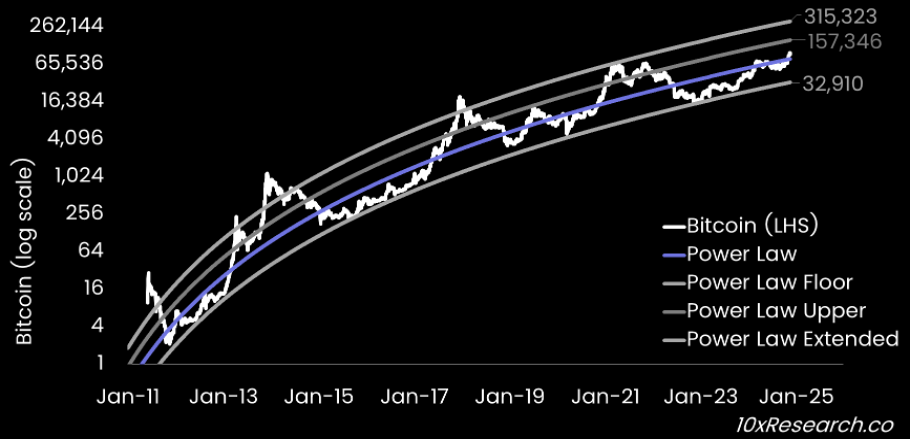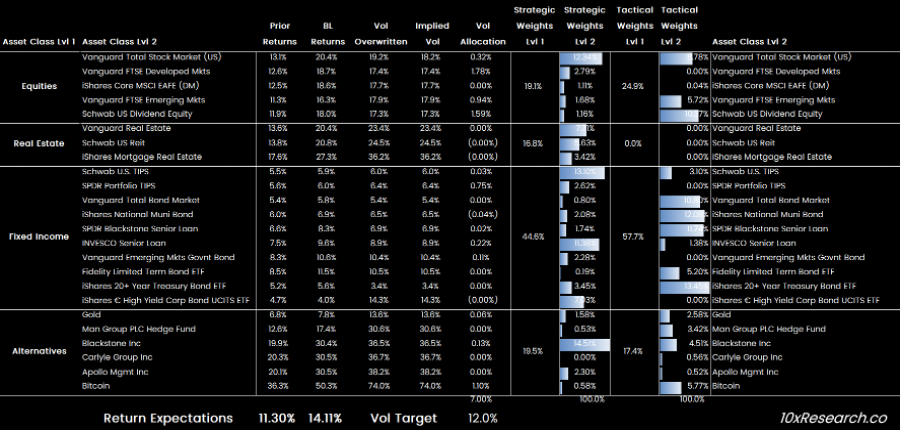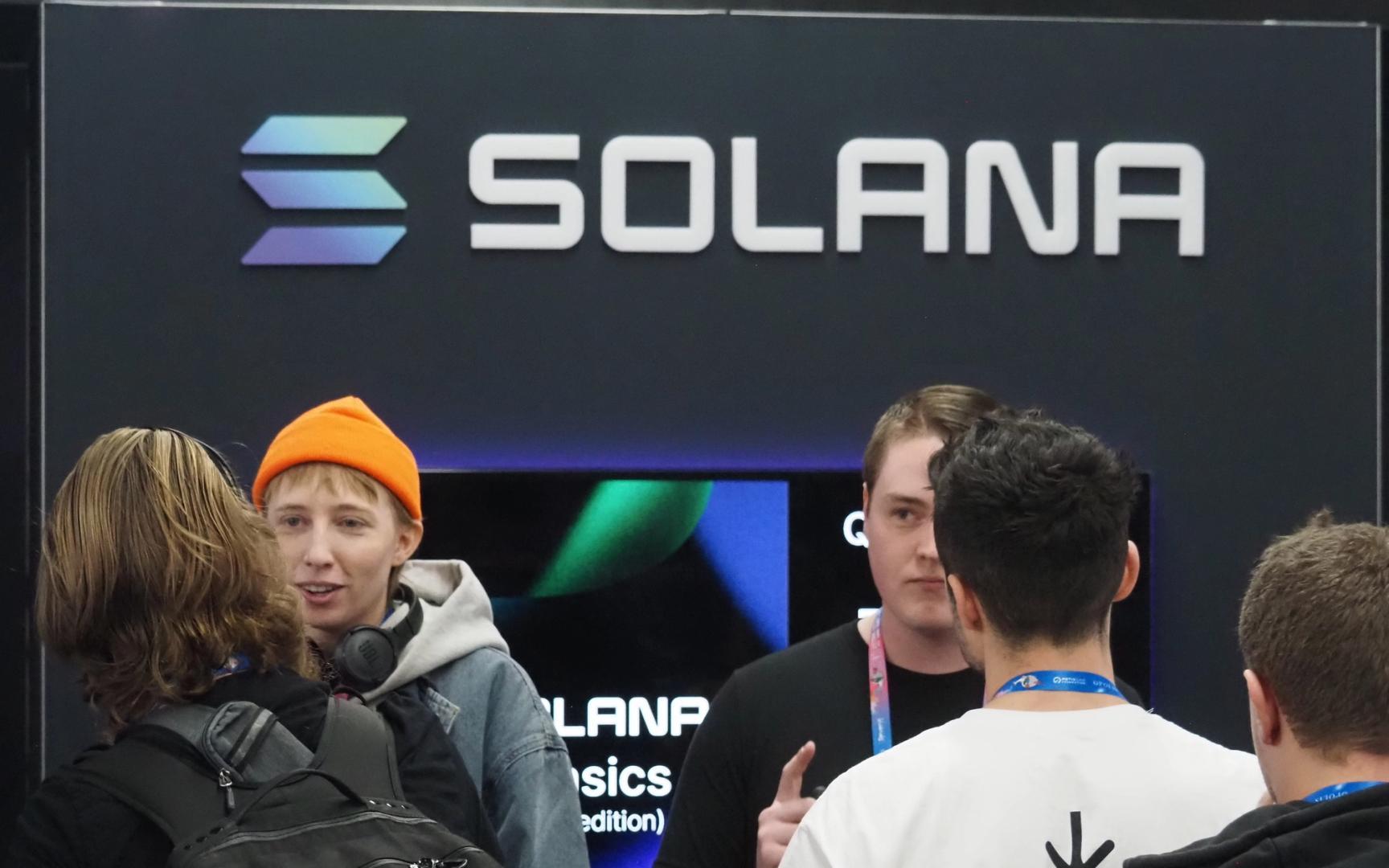Uncategorized
Three Questions Reveal Your Ideal Bitcoin Allocation

By answering three key questions on return expectations and target portfolio volatility, multi-asset investors can evaluate bitcoin’s suitability for their portfolios and determine its optimal allocation based on their unique goals.
Contrary to popular belief, bitcoin’s price is primarily driven by demand, not its (mining) supply. Each of bitcoin’s five bull markets has been propelled by innovations in how investors access it — ranging from the creation of early spot exchanges to the introduction of futures, uncollateralized borrowing, spot bitcoin ETFs, and now options on these ETFs. This evolution underscores bitcoin’s deepening integration into traditional financial markets, a trend accelerated by regulatory approvals from U.S. agencies like the CFTC and SEC, which have progressively legitimized bitcoin-based financial products.
The 2017 decision to retain Bitcoin’s 1-megabyte (MB) block size marked the resolution of a long-standing debate within the Bitcoin community on scaling the network. Originally implemented to manage congestion and uphold decentralization, the block size limit became a defining feature. By prioritizing decentralization over higher transaction throughput, this decision cemented bitcoin’s role as «digital gold.»
This framework helps traditional finance investors understand bitcoin’s role as digital gold, a risk mitigation tool or an inflation hedge, and offers insights into its valuation potential. While bitcoin is unlikely to disrupt jewelry ($8 trillion), it could capture portions of the $10 trillion addressable market, including private investments ($4 trillion), central bank reserves ($3.1 trillion), and industrial use ($2.7 trillion). With bitcoin’s current market cap at $2 trillion, this suggests a potential 5x growth as it solidifies its position as digital gold.
Exhibit 1: Bitcoin (log chart) power law curves

The fundamental distinction is Bitcoin’s nature as a technology with strong network effects, which gold inherently lacks. Network technologies often follow an «S-curve» adoption model, with mass adoption accelerating once the critical 8% threshold is surpassed.
With a market capitalization of $2 trillion, bitcoin represents just 0.58% of the nearly $400 trillion global financial asset portfolio. This share is poised to increase as asset managers, pension funds, and sovereign wealth funds progressively integrate bitcoin into their investment strategies.
To strategically integrate bitcoin into a forward-looking, Markowitz-optimized portfolio, investors must address three key questions:
How is bitcoin expected to perform relative to equities?
How will equities perform relative to bonds?
What is the target portfolio’s overall volatility?
These insights drive more informed allocation decisions within multi-asset portfolios.
Exhibit 2: Optimal multi-asset allocation based on our expected return/risk parameters

For example, if bitcoin is projected to outperform U.S. stocks by +30% in 2025, U.S. stocks outperform U.S. bonds by +15%, and the portfolio targets a 12% volatility level, the following adjustments occur: equities increase from 19.1% to 24.9%, real estate drops from 16.8% to 0%, fixed income rises from 44.6% to 57.7%, and alternatives (including private equity, hedge funds, gold, and bitcoin) decrease from 19.5% to 17.4%. Notably, bitcoin’s allocation jumps significantly — from 0.58% (based on its current market share of the $400 trillion global financial asset pool) to 5.77%.
This adjustment boosts the portfolio’s expected return from 11.3% to 14.1%, leveraging a volatility-targeted Black-Litterman-optimized framework, which is an analytical tool to optimize asset allocation within an investor’s risk tolerance and market views. By answering these key questions and applying this approach, investors can determine their ideal bitcoin allocation.
Uncategorized
AVAX Surges 10.7% as Bullish Breakout Signals Strong Momentum

Avalanche’s AVAX token has broken out of its multi-week correction phase, demonstrating remarkable strength despite ongoing geopolitical tensions affecting cryptocurrency markets.
The broader market gauge, CoinDesk 20 Index (DLCS), has demonstrated exceptional bullish momentum, surging from 1403.33 to 1461.17 in the last 48 hours, representing a 4.12% gain, while the overall range spans 95.56 points (6.97%) from the low of 1365.61 to the high of 1461.17.
The recent price action of AVAX shows accelerated momentum with the formation of a bull flag pattern and decisive breakout above $20.40, coinciding with significant institutional developments in the ecosystem, according to CoinDesk Research’s technical analysis data.
Technical Analysis Highlights
- AVAX demonstrated remarkable strength, surging from 18.87 to 20.89, representing a 10.7% gain.
- Price action reveals a clear bullish trend with higher lows forming a strong support trendline around 19.50.
- After consolidating between 19.30-19.70 on April 20, AVAX experienced a significant breakout on April 21, with volume increasing substantially as the price pushed above 20.00.
- The most recent 48 hours show accelerated momentum with the formation of a bull flag pattern and a decisive breakout above 20.40, suggesting further upside potential.
- Key resistance at 20.90 now becomes the level to watch, with Fibonacci extension targets pointing to 21.50 as the next significant objective.
- In the last 100 minutes, AVAX surged from 20.61 to 21.04, representing a 2.1% gain.
- After consolidating between 20.50-20.60 during the 13:20-13:40 timeframe, price formed a solid base before initiating a powerful upward move.
- The decisive breakout occurred at 14:40 with extraordinary volume (146,387 units), creating a strong support level at 20.80.
- Multiple high-volume candles followed between 14:44-14:48, pushing the price through the critical 21.00 psychological barrier with the highest volume spike (142,112 units) at 14:47.
- This breakout completes the bullish pattern established in the previous 48 hours, with Fibonacci extension targets now suggesting 21.50 as the next significant objective.
Disclaimer: This article was generated with AI tools and reviewed by our editorial team to ensure accuracy and adherence to our standards. For more information, see CoinDesk’s full AI Policy. This article may include information from external sources, which are listed below when applicable.
External References:
- «Avalanche (AVAX), Toncoin (TON) and Kaspa (KAS): Can They Recover?« — CryptoDaily, published April 2025.
- «Avalanche (AVAX), Polkadot (DOT) Rebound on the Horizon? Harmonic Pattern Signals Bullish Move» — Bitzo, published April 2025. — Bitzo, published April 2025. — Bitzo, published April 2025.
- «Avalanche Price Prediction« — Cryptopolitan, published April 2025.
- «Avalanche Card Unveiled: Will It Spark Bullish Momentum for AVAX?« — Coinpedia, published April 2025.
Uncategorized
Janover Buys Another $11.5M in SOL, Gets Renamed Amid Crypto Treasury Strategy Play

Janover (JNVR), the real estate-focused fintech company with a Solana (SOL) treasury strategy, has been renamed to DeFi Development Corp and purchased another $11.5 million worth of SOL tokens, the firm said on Tuesday.
The move brings the company’s total SOL holdings to 251,842, including staking rewards, the company said. That’s valued at around $36.5 million, with SOL currently trading around $145.
JNVR shares were down 2.5% today at $38.3, well below last week’s peak just shy of $80. However, the stock is still up over 800% since adopting the crypto treasury strategy. SOL advanced nearly 5% over the past 24 hours, with the broader crypto market climbing higher.
The purchase was part of the Boca Raton, Florida-based company’s new crypto bet to position itself as the first U.S.-listed company with a treasury strategy centered on Solana and its native token SOL.
As part of the strategy, the firm seeks to accumulate SOL and operate one or more validators to secure the blockchain. The pivot happened after a team of former executives of crypto exchange Kraken bought a majority stake in the firm earlier this month.
Read more: Janover Takes Page From Saylor Playbook, Doubling SOL Stack to $20M as Stock Soars 1700%
The purchase was made using funds from a $42 million financing round the company completed earlier this year. Based on the latest figures, each share of the company represents 0.17 SOL, up 62% from its last crypto purchase, according to the press release.
The firm will also change its ticker to DFSV on the Nasdaq exchange at a future date to reflect its new name.
Last week, the company announced a strategic partnership with Kraken with plans to delegate part of the exchange’s SOL holdings to stake to validators operated by DeFi Development Corp. The firm also teamed up with BitGo to acquire locked tokens via over-the-counter markets.
Uncategorized
Arch Labs Raises $13M in Funding for Bitcoin-Based Smart Contracts

Bitcoin decentralized finance (DeFi) developer Arch Labs raised $13 million in funding toward building «ArchVM,» which the developers say will provide smart-contract functionality on the original blockchain.
The funding round, which valued the company at $200 million, was led by Pantera Capital, according to an announcement on Tuesday.
Arch’s plans to enable decentralized applications and protocols natively on Bitcoin.
ArchVM will handle off-chain computations to enable «Turing-complete smart contracts at the Bitcoin base layer» and provide Solana-like transaction speeds, Arch Labs said in the announcement.
The goal of introducing smart contracts to Bitcoin began to gather steam in October with the release of the BitVM computing language.
Numerous projects are now using BitVM as the basis for bringing smart contracts to Bitvcoin via layer-2 networks or bridges. Arch’s aim is to avoid the need to bridge assets to layer-2s, which could present additional risks.
-

 Fashion6 месяцев ago
Fashion6 месяцев agoThese \’90s fashion trends are making a comeback in 2017
-

 Entertainment6 месяцев ago
Entertainment6 месяцев agoThe final 6 \’Game of Thrones\’ episodes might feel like a full season
-

 Fashion6 месяцев ago
Fashion6 месяцев agoAccording to Dior Couture, this taboo fashion accessory is back
-

 Entertainment6 месяцев ago
Entertainment6 месяцев agoThe old and New Edition cast comes together to perform
-

 Sports6 месяцев ago
Sports6 месяцев agoPhillies\’ Aaron Altherr makes mind-boggling barehanded play
-

 Business6 месяцев ago
Business6 месяцев agoUber and Lyft are finally available in all of New York State
-

 Entertainment6 месяцев ago
Entertainment6 месяцев agoDisney\’s live-action Aladdin finally finds its stars
-

 Sports6 месяцев ago
Sports6 месяцев agoSteph Curry finally got the contract he deserves from the Warriors





